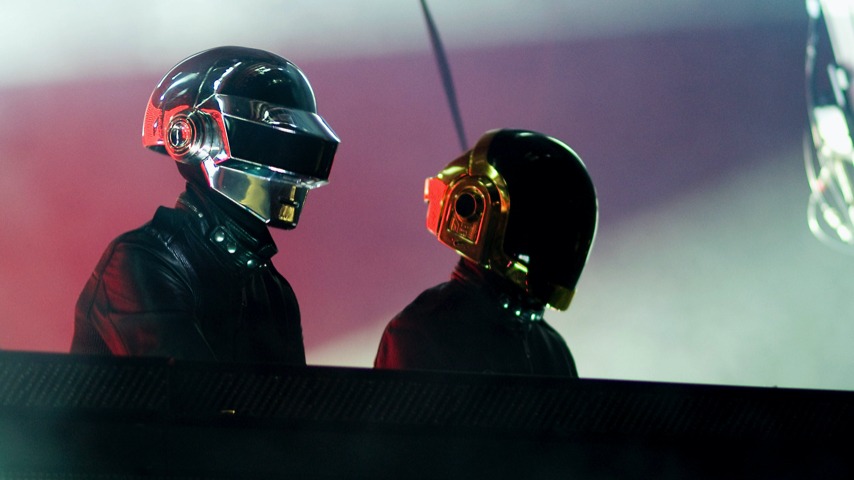After reigning as of one dance music’s most enduring and important acts for nearly three decades, Daft Punk called it quits on Monday, announcing their shutdown eight years after the release of their last—and now final—album. It’s an odd time for the Parisian robots to walk away, given that no one had necessarily been holding their breath for new music from them any time soon, but they leave behind an absolutely stellar body of work, from their 1997 debut Homework to 2013’s Grammy-vacuuming comeback Random Access Memories. In honor of Guy-Manuel de Homem-Christo and Thomas Bangalter’s singular output, we’ve taken the liberty of ranking its 20 best entries, a selection of blissful, meticulously crafted electronic tracks that will always have a place on dance floors worldwide.
20. “High Fidelity”
This Homework standout presaged Discovery’s sample-heavy love letter to the late ‘70s, extrapolating pieces of Billy Joel’s The Stranger single “Just the Way You Are” into a propulsive, euphoric house track. You can hear all the distinct strands of Daft Punk’s DNA across this song, from its economic drum machine loop to the dynamic, unerringly melodic way they deploy the rest of its instrumentation.
19. “Lose Yourself to Dance (feat. Pharrell Williams)”
The robots teamed up with Pharrell Williams only twice on Random Access Memories, but the 13-time Grammy winner made those collaborations count, lending his vocals to two of that album’s biggest hits. “Lose Yourself to Dance” is the lesser of the pair, obviously, but it’s also one of the funkiest tracks Daft Punk ever put out, with a major assist from Nile Rodgers of Chic on guitar. Despite its live-band feel, the song is a deceptively potent dance-floor jam—one can’t help but take Pharrell’s advice.
18. “Television Rules the Nation”
This Human After All track aims to do for your ears what its eponymous small screen does for your eyes, holding them in its sway to the point that you forget whatever else is happening around you. Only three distinct elements—an unflagging drum machine, heavily distorted power chords and robotic vocals repeating its title—make up most of the song, with its synth and guitar palette blooming and buzzing in the choruses. As is often the case with Daft Punk, the song’s simplicity is its power, featuring just enough instrumentation to compel you not to take your ears off it.
17. “Instant Crush (feat. Julian Casablancas)”
This Random Access Memories cut is to The Strokes as “Doin’ It Right” is to Animal Collective, with the robots borrowing a member of each band and dropping them—surprisingly seamlessly—into a track that’s not quite typical of any of the artists involved. It would appear “Instant Crush” is what introduced Julian Casablancas to the love of his non-Strokes life, the vocoder, which polishes his stylishly gritty voice into more of a delicate, fluttering coo, and fits all the better with the song’s yearning and vulnerable lyrics. Palm-muted guitar, a buzzy bass thrum and soft synth arpeggios follow Casablancas into his feelings, contrasting Strokes-y sharp edges with the fizzy lift of a Daft Punk love song.
16. “Something About Us”
The comedown after “High Life”’s euphoria on Discovery, “Something About Us” is driven by quiet keys and funky guitar and bass, the rare reminder that Daft Punk could soundtrack a slow dance just as expertly as a wild one when they wanted. The robots get intimate and make a romantic case via vocoder, acknowledging the risk of unrequited love before laying all their cards on the table (“I need you more than anything in my life / I want you more than anything in my life”). A muted, yet jazzy guitar solo stokes the track’s romantic flame some more, but “Something About Us” fades away before it can burn out.
15. “Harder, Better, Faster, Stronger”
Though long since eclipsed in the public consciousness by its sampling on Kanye West’s nine-times-platinum single “Stronger,” this Discovery cut harkens back to the stripped-down danceability of their debut, laying down a springy sample of Edwin Birdsong’s “Cola Bottle Baby,” and a stuttering beat and bassline lockstep. The duo overlay that with the song’s iconic vocoder-assisted vocals, leaning into their robot personas via the tireless repetition of their disyllabic lyrics, then letting them degrade during the song’s funk-forward breakdown.
14. “Technologic”
A banger from Human After All’s back half, “Technologic” lands somewhere between “Robot Rock” and “Harder, Better, Faster, Stronger” with its emphases on heavily filtered guitar chords and repeated imperative lyrics, the two elements combining to create a particularly hypnotic groove. Those lyrics are delivered not via Daft Punk’s typical autotuned vocals, but by a more high-pitched, almost childlike voice, like either an external machine or an inner monologue handing out commands (“Buy it, use it, break it, fix it”), both in an endless cycle and to unclear ends. What “Technologic” lacks in warmth, it makes up for with calculated mesmerism, subtly shifting to keep your ear engaged.
13. “Make Love”
One of Human After All’s most subdued tracks, “Make Love” is the closest to “haunting” a Daft Punk song has ever sounded. Compared to, say, “Robot Rock,” which crashes into the mix with a flurry of drums just two tracks earlier, “Make Love” fades in like the moon coming out from behind dark clouds, looping a gorgeous piano figure over a muted guitar, and the softly crackling snares and bass heartbeat of a drum machine. An autotuned voice seeps into the mix from no discernible point of origin, urging “Make love, make love” over and over. It’s one of the definitive Daft Punk slow jams, made even more remarkable by the fact that it stands out so much from the rest of Human After All.
12. “Da Funk”
Originally released in 1995 before appearing on Homework two years later, “Da Funk” was Daft Punk’s first commercial hit, blending the booming bass of West Coast g-funk (Daft Punk are said to have cited Warren G’s “Regulate” as an inspiration for the track) with inventive electronic sounds. A hammering kick-drum provides the backbone of the song, while a swirling synth riff that sounds like it’s actively corroding takes turns with a simplistic house loop, but halfway through, the song shifts to another irradiated synth figure—when all these elements come together soon after, the payoff is enormous. “Da Funk” reappears in reverse as Homework’s final track, “Funk Ad,” as if Daft Punk knew the song deserved one last tip of the cap.
11. “High Life”
This song from Discovery’s midsection returns to the late-’70s funk and soul sample well, transforming Tavares’ “Break Down For Love” into a joyous house anthem. Daft Punk pitch the Tavares brothers’ voices up past recognizable, chopping their vocals into stray syllables that are no less ebullient and uplifting for their unintelligibility. That and a surprisingly lovely string-driven breakdown make this song stand out, even on Daft Punk’s best album.
10. “Indo Silver Club”
This Homework single, a gem from the back half of Daft Punk’s first full-length, lures you in with exuberant guitar strums sampled from Karen Young’s late-’70s disco hit “Hot Shot,” then introduces a rubber band of a deep-house groove. The shifting give-and-take between those two through lines is what makes this song so mesmerizing—just when you think you have it pinned down, it’s on the move again.
9. “Get Lucky”
One of the most inescapable hits of the 2010s, “Get Lucky” introduced Daft Punk to a new generation who knew them only as a massive influence on all their favorite EDM artists (and were likely disappointed to find it didn’t have a “drop”). “Lose Yourself to Dance” duo Pharrell Williams and Nile Rodgers of Chic provide a similar interplay here, with the former’s breezy vocals rendering the track’s weapons-grade hooks, and the latter’s guitar strums providing its bright backbone. The robots add their signature vocoderized voices, as well, as if to lend their support to the endless pursuit of luckiness. You’ll be hearing this song at weddings until the day you die.
8. “Robot Rock”
The lead single from the black sheep of (read: least raved-about entry in) Daft Punk’s catalog, Human After All, “Robot Rock” is exactly what it sounds like. A sample of Breakwater’s “Release the Beast” is the song’s foundation, winning half the battle on its own, but de Homem-Christo and Bangalter put their distinct spin on it, subtly transforming the 1980 track’s funk swagger into a clipped, mechanical march fit for an automaton. The vocoderized refrain adds to the track’s droning, hypnotic vibe, but the wisest decision Daft Punk make is letting Breakwater’s killer riff ride, chopping it up for complexity’s sake, but never throwing off its groove.
7. “Rollin’ & Scratchin’”
This Homework track is Daft Punk at their most ruthlessly minimalistic, a skeletal, glitched-out rave-up that’s all the more jarring because it immediately follows “Around the World.” Dark, insistent drums meet a series of nerve-fraying, heavily distorted synths, the two sides sometimes colliding, other times receding to make space for the other. “Rollin’ & Scratchin’” feels edgy, even dangerous, in a way that’s uncommon in Daft Punk’s catalog, as if they were using their musical powers not to lift your troubles off you, but to catch and keep you in their thrall until you dance yourself to death, Suspiria-style.
6. “Doin’ It Right (feat. Panda Bear)”
One of the most beloved songs off Random Access Memories, “Doin’ It Right” combines Daft Punk’s slinky, cyclical production with Panda Bear, born Noah Lennox, and best-known as a founding member of Animal Collective. Lennox’s artfully layered vocals provide a more accessible counterpoint to de Homem-Christo and Bangalter’s steely, auto-tuned incantations, which interweave over a drum machine backbeat and quiet synth work. The song takes a lyrical tack similar to some of Daft Punk’s very best, with Lennox urging escapism by way of the dance floor: “If you lose your way tonight / That’s how you know the magic’s right.”
5. “Short Circuit”
The most loaded album in Daft Punk’s discography, Discovery tucks this techno-disco blood-pumper into the murderers row that is its last few tracks. Part of what makes “Short Circuit” so memorable is its unusual arrangement: What starts out as a fast-paced, pulsating electro-funk number burns through all its energy by the halfway point, fading into a woozy tangle of synths. But the resurgence you naturally anticipate never comes, and the song continues its collapse into increasingly glitched-out synth-pop, finally fading out into silence—and even then, it’s difficult to accept it’s really over. “Short Circuit” is the rare song where Daft Punk tease you with a groove, then take it away, bucking their typical tendencies and leaving you wanting much more.
4. “Face to Face”
Discovery’s penultimate cut is among its loveliest, a collaboration with producer and singer Todd Edwards (who would later contribute vocals to “Fragments of Time,” off Random Access Memories). Daft Punk pull a sample from ELO’s “Evil Woman,” building a dance track that feels far shiftier than its 4/4 beat would suggest. Edwards’ vocal tone doesn’t exactly leap off the track, but his melody and lyrics bring a human element to “Face to Face” as he reaches out to make a connection—to “get involved, face to face.” The interplay between the robots’ crate-digging wizardry and Edward’s everyman self-expression makes this song special.
3. “Around the World”
One of Daft Punk’s first hits and Homework’s biggest, “Around the World” is the duo at their cleverest: The track parlays its titular three words (which repeat 144 times on the album version, in case you were curious) into a seven-plus-minute dance-funk thumper, with little more than punchy 4/4 drums and squelchy synthesized bass to back it up. That’s basically all there is to it, and it’s a devilish flex on Daft Punk’s part to string such a relatively simplistic groove out for so long, yet keep you rapt for its entire runtime. Big bonus points for Michel Gondry’s iconic music video, which plays out like a Busby Berkeley film on club drugs.
2. “One More Time”
Discovery’s opening track and one of Daft Punk’s biggest-ever hits, “One More Time” is one of the giddiest, most irresistible pieces of dance music this side of Y2K. Daft Punk chop up and repurpose horns from Eddie Johns’ 1979 track “More Spell on You” to the point they’re all but untraceable, dropping them into a four-on-the-floor groove that could go on forever. Romanthony’s carefree autotuned vocals fit perfectly with the robots’ instrumentation, verbalizing the exact desire for a never-ending dance party that “One More Time” so effortlessly inspires.
1. “Digital Love”
Only one song could ever knock “One More Time” off the Daft Punk masterstroke mountaintop, and it’s “Digital Love,” a dreamlike electro-pop revery that calms as much as it invigorates. Batting clean-up on Discovery, the track is the perfect distillation of the album’s long-form homage to the music of de Homem-Christo and Bangalter’s childhoods, transforming the guitar and synth riff from George Duke’s 1979 funk track “I Love You More” into the gleaming centerpiece of a lovesick 4/4 stomper that’s hiding a broken heart. The song breaks down and builds itself back up, one Wurlitzer becoming two, with vocoderized vocals begging of their affection’s object, “Why don’t you play the game?” A guitar solo that sounds like it’s being beamed in from another galaxy is the finishing touch on Daft Punk’s finest five minutes.
Scott Russell is an associate music editor at Paste and he’ll come up with something clever later. He’s on Twitter, if you’re into tweets: @pscottrussell.




